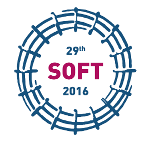Speaker
Takafumi Okita
(Division of Sustainable Energy and Environmental Engineering)
Description
Liquid metal flow has been expected to be applied in various fields. For example, sodium and lithium (Li) are applied as a coolant in the fast-breeder reactor and space nuclear reactor, Li jet as a beam target in the International Fusion Materials Facility (IFMIF) and as a charge stripper in Radioactive Isotope Beam Facility (RIBF) at RIKEN, lithium-lead (Li-Pb) as a liquid metal blanket in a Helical-type fusion reactor and so on. Especially, since the Li jet must flow with high velocity for a heat removal in the IFMIF and the RIBF, the surface of it might fluctuate. The surface fluctuation causes the increasing of the damage risk of the flow channel and the moderation of the generated neutron in the IFMIF, and the diffusion of beam profile passing through the fluctuating Li jet leads to the low beam intensity in the RIBF. So, in these facilities, it is strongly desirable to suppress such surface fluctuation of the Li jet. In this study, we verify suppression of the surface fluctuation of it by Magneto-Hydro-Dynamics (MHD) effect. Results in this research on MHD effect to liquid metal contribute to the development not only of a beam target in the IFMIF and RIBF but also of the Li-Pb blanket, in which the heat transfer under strong magnetic field could determine the performance.
In this study, we designed and made magnet-insertion apparatus for applying a magnetic field to the Li jet in the liquid Li circulation loop at Osaka University, and the experiment with this apparatus was conducted. The insertion system consists of a magnet part for applying magnetic field with two Samarium-Cobalt magnets, an iron core and the up-and-down driving system. In this experiment, by driving the magnet part, the surface shape with/without the magnetic field could be observed.
Co-authors
Eiji Hoashi
(Division of Sustainable Energy and Environmental Engineering, Graduate School of Engineering, Osaka University, Osaka, Japan)
Hiroki Okuno
(RIKEN, Saitama, Japan)
Hiroshi Horiike
(Department of Applied Nuclear Technology, Faculty of Engineering, Fukui University of Technology, Fukui, Japan)
Junya Morioka
(Division of Sustainable Energy and Environmental Engineering, Graduate School of Engineering, Osaka University, Osaka, Japan)
Takafumi Okita
(Division of Sustainable Energy and Environmental Engineering, Graduate School of Engineering, Osaka University, Osaka, Japan)

